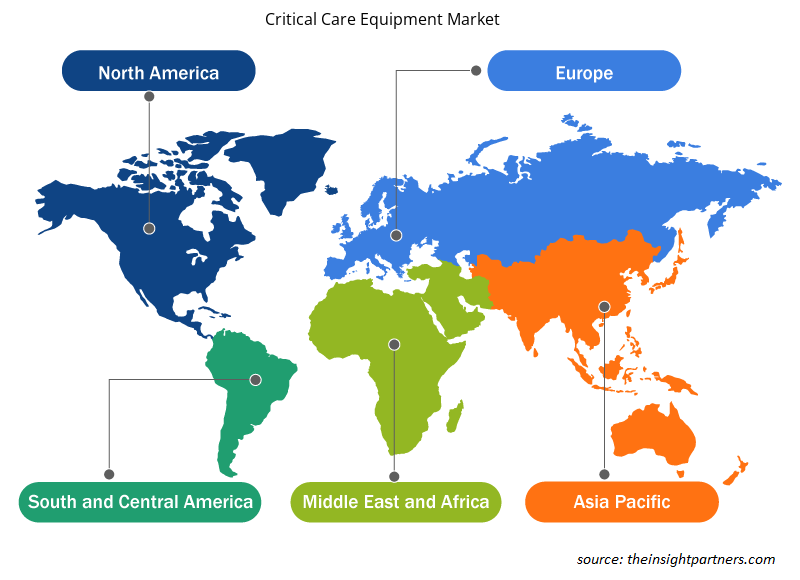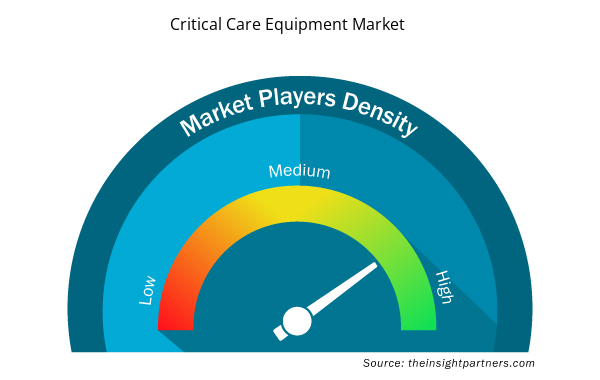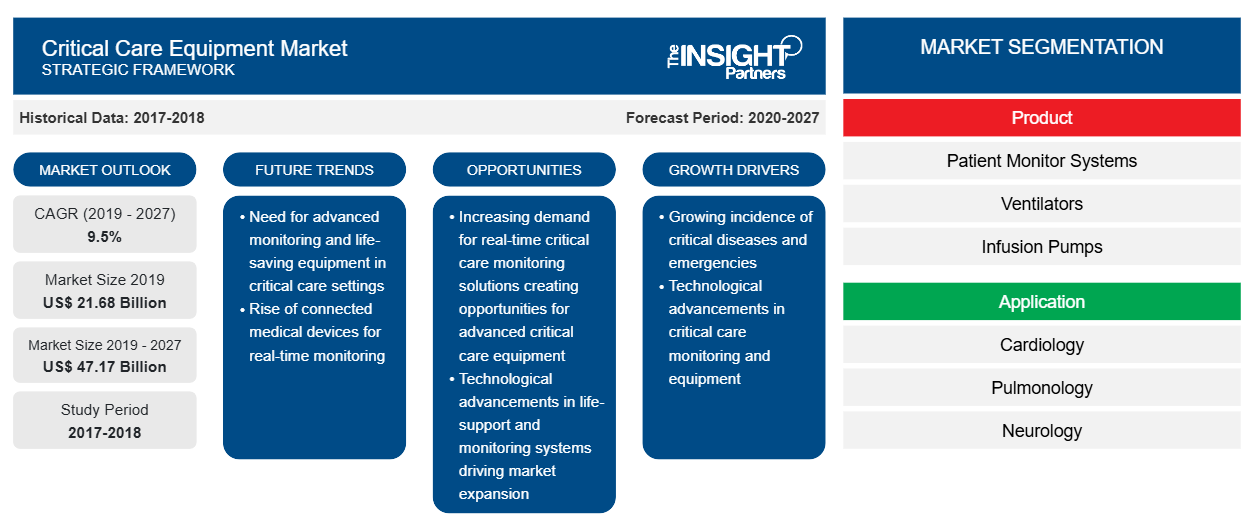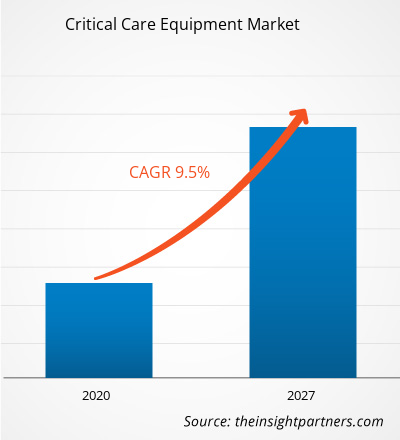2019 年重症监护设备市场价值为216.8265 亿美元,预计到 2027 年将达到 471.7142 亿美元;预计 2020-2027 年期间的复合年增长率为 9.5%。
感染患者平均要在重症监护室待 15 天。欧洲麻醉学会称,意大利重症监护病床数量持续增长。在伦巴第大区,在冠状病毒传播之前,有 140 张私人重症监护病床和 500 张公共重症监护病床,到 2020 年 3 月底,这些病床数量增加到 900 多张。
定制此报告以满足您的需求
您可以免费定制任何报告,包括本报告的部分内容、国家级分析、Excel 数据包,以及为初创企业和大学提供优惠和折扣
- 获取此报告的关键市场趋势。这个免费样品将包括数据分析,从市场趋势到估计和预测。
市场洞察
COVID-19 流行率较高的国家 ICU 病床数量不断增加,推动市场增长
2020 年 3 月 11 日,世界卫生组织宣布 COVID-19 为全球大流行病。这种新型疾病的特点是最初病例数较少,随后在各国出现感染爆发。尽管各国实施了封锁措施以减少 COVID-19 的传播,但各国的医疗保健系统仍因对设备的需求而难以承受,例如 ICU 病床和治疗重症病例的辅助设备。
产品洞察
就产品而言,患者监护系统部门在 2019 年占据了最大的市场份额,预计在预测期内将继续保持领先地位。然而,呼吸机部门预计在预测期内将在市场上实现更高的复合年增长率。
应用程序洞察
根据应用,全球重症监护设备市场细分为心脏病学、肺病学、神经病学、骨科等。心脏病学部门在 2019 年占据了最大的市场份额,预计肺病学部门在预测期内的复合年增长率最高。心血管重症监护是对患有严重心血管疾病 (CVD) 患者的系统管理,包括血管疾病和心脏病。心血管疾病是全球主要死亡原因之一。例如,根据世界卫生组织的数据,2016 年,估计有 1790 万人死于心血管疾病,占全球死亡人数的 31%。同样,根据疾病控制和预防中心的数据,每年约有 655,000 名美国人死于心脏病。为了防止因心血管疾病死亡,综合医院设有重症心血管疾病患者的重症监护病房,即心血管重症监护病房 (CICU)。临床心脏病学技术的发展,如冠状动脉介入治疗和设备、侵入性血流动力学监测等,是心血管重症监护的主要发展方向。因此,每年入住CICU的严重心血管疾病患者数量都在增加。CICU中的患者有许多并发症,如呼吸衰竭和肾功能衰竭。因此需要经过培训的医护人员进行系统性的重症监护。
预计重症监护设备市场参与者为弥补供需缺口而建立的合作和技术伙伴关系将在预测期内对市场增长发挥重要作用。
重症监护设备市场区域洞察
Insight Partners 的分析师已详尽解释了预测期内影响重症监护设备市场的区域趋势和因素。本节还讨论了北美、欧洲、亚太地区、中东和非洲以及南美和中美洲的重症监护设备市场细分和地理位置。

- 获取重症监护设备市场的区域特定数据
重症监护设备市场报告范围
| 报告属性 | 细节 |
|---|---|
| 2019 年市场规模 | 216.8亿美元 |
| 2027 年市场规模 | 471.7亿美元 |
| 全球复合年增长率(2019 - 2027) | 9.5% |
| 史料 | 2017-2018 |
| 预测期 | 2020-2027 |
| 涵盖的领域 | 按产品
|
| 覆盖地区和国家 | 北美
|
| 市场领导者和主要公司简介 |
|
重症监护设备市场参与者密度:了解其对业务动态的影响
重症监护设备市场正在快速增长,这得益于终端用户需求的不断增长,而这些需求又源于消费者偏好的不断变化、技术进步以及对产品优势的认识不断提高等因素。随着需求的增加,企业正在扩大其产品范围,进行创新以满足消费者的需求,并利用新兴趋势,从而进一步推动市场增长。
市场参与者密度是指在特定市场或行业内运营的企业或公司的分布情况。它表明相对于给定市场空间的规模或总市场价值,有多少竞争对手(市场参与者)存在于该市场空间中。
在重症监护设备市场运营的主要公司有:
- 通用电气公司
- 美敦力
- B. Braun Melsungen AG
- 百特国际公司
- 荷兰皇家飞利浦公司
免责声明:上面列出的公司没有按照任何特定顺序排列。

- 了解重症监护设备市场顶级关键参与者概况
按产品
- 病人监护系统
- 呼吸机
- 侵入式呼吸机
- 无创呼吸机
- 输液泵
- 其他的
按应用
- 心脏病学
- 肺病学
- 神经病学
- 骨科
- 其他的
按最终用户
- 医院
- 门诊护理中心
- 家庭护理
- 其他的
按地理位置
- 北美
- 我们
- 加拿大
- 墨西哥
- 欧洲
- 法国
- 德国
- 意大利
- 英国
- 俄罗斯
- 亚太地区 (APAC)
- 中国
- 印度
- 韩国
- 日本
- 澳大利亚
- 中东和非洲 (MEA)
- 南非
- 沙特阿拉伯
- 阿联酋
- 南美洲和中美洲(SCAM)
- 巴西
- 阿根廷
公司简介
- 通用电气公司
- 美敦力
- B. Braun Melsungen AG
- 百特国际公司
- 荷兰皇家飞利浦公司
- 洁定公司
- 瑞士哈美顿医疗公司
- 洛文斯坦医疗英国有限公司
- 德尔格股份公司
- 日本光电公司
- 费雪派克医疗保健有限公司。
- 深圳迈瑞生物医疗电子股份有限公司
- 布隆迪电力公司
- Trivitron医疗保健
- 斯堪雷科技有限公司
- 旭化成公司
- 历史分析(2 年)、基准年、预测(7 年)及复合年增长率
- PEST 和 SWOT 分析
- 市场规模价值/数量 - 全球、区域、国家
- 行业和竞争格局
- Excel 数据集



Report Coverage
Revenue forecast, Company Analysis, Industry landscape, Growth factors, and Trends

Segment Covered
This text is related
to segments covered.

Regional Scope
North America, Europe, Asia Pacific, Middle East & Africa, South & Central America

Country Scope
This text is related
to country scope.
常见问题
The disruption of supply chain and logistics due to the rapid spread of COVID-19 is the significant factor that will hinder the critical care equipment market growth.
The global critical care equipment market is being driven by factors such growing number of ICU beds in countries with a high prevalence of COVID-19 and increasing demand for ventilators for the effective management of critical COVID-19 patients. Furthermore, technological innovations in critical care equipment is likely to offer significant opportunities for the growth of the global critical care equipment market.
Critical care equipment includes cardiac support, patient monitoring, respiratory support, emergency resuscitation devices, pain management, and other life support equipment designed to care for critically ill patients or have undergone a major surgical procedure, thereby requiring 24-hour care monitoring.
Trends and growth analysis reports related to Life Sciences : READ MORE..
The List of Companies - Critical Care Equipment Market
- General Electric Company
- Medtronic
- B. Braun Melsungen AG
- Baxter International Inc.
- Koninklijke Philips N.V.
- Getinge AB
- Hamilton Medical
- Löwenstein Medical UK Ltd.
- Dragerwerk AG & Co. KGaA
- Nihon Kohden Corporation
- Fisher & Paykel Healthcare Limited.
- Shenzhen Mindray Biomedical Electronics Co., Ltd.
- BPL
- Trivitron Healthcare
- Skanray Technologies Pvt Ltd
- Asahi Kasei Corporation
The Insight Partners performs research in 4 major stages: Data Collection & Secondary Research, Primary Research, Data Analysis and Data Triangulation & Final Review.
- Data Collection and Secondary Research:
As a market research and consulting firm operating from a decade, we have published and advised several client across the globe. First step for any study will start with an assessment of currently available data and insights from existing reports. Further, historical and current market information is collected from Investor Presentations, Annual Reports, SEC Filings, etc., and other information related to company’s performance and market positioning are gathered from Paid Databases (Factiva, Hoovers, and Reuters) and various other publications available in public domain.
Several associations trade associates, technical forums, institutes, societies and organization are accessed to gain technical as well as market related insights through their publications such as research papers, blogs and press releases related to the studies are referred to get cues about the market. Further, white papers, journals, magazines, and other news articles published in last 3 years are scrutinized and analyzed to understand the current market trends.
- Primary Research:
The primarily interview analysis comprise of data obtained from industry participants interview and answers to survey questions gathered by in-house primary team.
For primary research, interviews are conducted with industry experts/CEOs/Marketing Managers/VPs/Subject Matter Experts from both demand and supply side to get a 360-degree view of the market. The primary team conducts several interviews based on the complexity of the markets to understand the various market trends and dynamics which makes research more credible and precise.
A typical research interview fulfils the following functions:
- Provides first-hand information on the market size, market trends, growth trends, competitive landscape, and outlook
- Validates and strengthens in-house secondary research findings
- Develops the analysis team’s expertise and market understanding
Primary research involves email interactions and telephone interviews for each market, category, segment, and sub-segment across geographies. The participants who typically take part in such a process include, but are not limited to:
- Industry participants: VPs, business development managers, market intelligence managers and national sales managers
- Outside experts: Valuation experts, research analysts and key opinion leaders specializing in the electronics and semiconductor industry.
Below is the breakup of our primary respondents by company, designation, and region:

Once we receive the confirmation from primary research sources or primary respondents, we finalize the base year market estimation and forecast the data as per the macroeconomic and microeconomic factors assessed during data collection.
- Data Analysis:
Once data is validated through both secondary as well as primary respondents, we finalize the market estimations by hypothesis formulation and factor analysis at regional and country level.
- Macro-Economic Factor Analysis:
We analyse macroeconomic indicators such the gross domestic product (GDP), increase in the demand for goods and services across industries, technological advancement, regional economic growth, governmental policies, the influence of COVID-19, PEST analysis, and other aspects. This analysis aids in setting benchmarks for various nations/regions and approximating market splits. Additionally, the general trend of the aforementioned components aid in determining the market's development possibilities.
- Country Level Data:
Various factors that are especially aligned to the country are taken into account to determine the market size for a certain area and country, including the presence of vendors, such as headquarters and offices, the country's GDP, demand patterns, and industry growth. To comprehend the market dynamics for the nation, a number of growth variables, inhibitors, application areas, and current market trends are researched. The aforementioned elements aid in determining the country's overall market's growth potential.
- Company Profile:
The “Table of Contents” is formulated by listing and analyzing more than 25 - 30 companies operating in the market ecosystem across geographies. However, we profile only 10 companies as a standard practice in our syndicate reports. These 10 companies comprise leading, emerging, and regional players. Nonetheless, our analysis is not restricted to the 10 listed companies, we also analyze other companies present in the market to develop a holistic view and understand the prevailing trends. The “Company Profiles” section in the report covers key facts, business description, products & services, financial information, SWOT analysis, and key developments. The financial information presented is extracted from the annual reports and official documents of the publicly listed companies. Upon collecting the information for the sections of respective companies, we verify them via various primary sources and then compile the data in respective company profiles. The company level information helps us in deriving the base number as well as in forecasting the market size.
- Developing Base Number:
Aggregation of sales statistics (2020-2022) and macro-economic factor, and other secondary and primary research insights are utilized to arrive at base number and related market shares for 2022. The data gaps are identified in this step and relevant market data is analyzed, collected from paid primary interviews or databases. On finalizing the base year market size, forecasts are developed on the basis of macro-economic, industry and market growth factors and company level analysis.
- Data Triangulation and Final Review:
The market findings and base year market size calculations are validated from supply as well as demand side. Demand side validations are based on macro-economic factor analysis and benchmarks for respective regions and countries. In case of supply side validations, revenues of major companies are estimated (in case not available) based on industry benchmark, approximate number of employees, product portfolio, and primary interviews revenues are gathered. Further revenue from target product/service segment is assessed to avoid overshooting of market statistics. In case of heavy deviations between supply and demand side values, all thes steps are repeated to achieve synchronization.
We follow an iterative model, wherein we share our research findings with Subject Matter Experts (SME’s) and Key Opinion Leaders (KOLs) until consensus view of the market is not formulated – this model negates any drastic deviation in the opinions of experts. Only validated and universally acceptable research findings are quoted in our reports.
We have important check points that we use to validate our research findings – which we call – data triangulation, where we validate the information, we generate from secondary sources with primary interviews and then we re-validate with our internal data bases and Subject matter experts. This comprehensive model enables us to deliver high quality, reliable data in shortest possible time.


 获取此报告的免费样本
获取此报告的免费样本